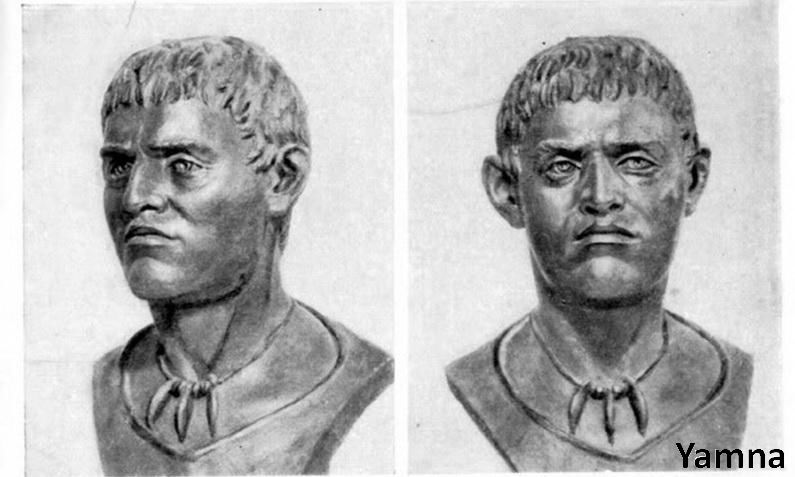Interesting. Thanks for the info Fire Haired.
Lots of questions, of course.
What happened to the concept that Corded Ware is 66% of a population "related to" Yamnaya? Is the abstract for this conference older than the other leak, or is it that Corded Ware is 75% Yamnaya but 66% a population related to Yamnaya. (This is what happens when there's all this speculation without having the actual paper in front of us.)
In terms of this particular "leak" what comprises northern Europe? Is it everything north of the Alps, Balkans, Pyrennees?
I'm not surprised at the late 2500 BC entry into Central Europe. I have thought for a long time that the dates of 3500 BC and even earlier were off, and that a number of the "Copper" Cultures that were once considered "Indo-European" were no such thing.
What was the autosomal make up of the 27% non Yamnaya ancestry in Corded Ware? Was it an even mix of EEF and WHG since they said there was a resurgence of WHG in northern Europe from 4,000 to 3,000 BC? Or was it still more EEF?* If it was, and the Yamnaya ancestry was, as they've said before and now, 50% "Near Eastern", then Corded Ware people would be more "ENF" and "ANE" then modern northern Europeans, as someone pointed out on that blog link. If that is the case, then I don't see how Corded Ware people can cluster with modern north Central Europeans, much less so with people from the extreme north east like Baltic peoples, as someone else on that blog pointed out. (In fact, it never made sense to me that they would. As I've pointed out before, Baltic peoples have far too little EEF or ENF to be good proxies for a Corded Ware population that is 73% Yamnaya (which is 50% Near Eastern), and would then have additional ENF from European farmers. The analyses done by bloggers purporting to show that they are don't comport with the evidence, in my opinion.
As for the amount in southern Europe, I wouldn't care to speculate about the final figures. I think the fact that so many "guesstimates" have been wrong should indicate that we just don't have enough data at present.
The fact that there seems to be another major "event" in European genetics around 1000 BC is also interesting, as is the fact that from 2500 BC to 1000 BC, a period of about 1500 years, there was a period of "stasis". I don't buy the idea that it just happened. If Reich and company are correct, it was not a continuous process of mixing, but instead was rather abrupt. Either there was another movement of people (perhaps from more northern areas), or whatever cultural or class "apartheid" that existed broke down around this time. At any rate, whatever it was dropped the similarity to Yamnaya from 73% to approximately 50%.
Finally, they seem to be very cautious about the linguistics side of the equation. Given that David Anthony is a consulting author on the paper, I didn't think that they'd dump the Pontic-Caspian steppe theory, so I'm not surprised to see that they see it as explaining some of the language change, but it's interesting that they are cautious about attributing all the language change to it. This raises the question as to whether the "Centum" languages, or perhaps Greek and Anatolian, had a slightly different (perhaps geographically contiguous) source, and a slightly different trajectory.
Aberdeen: If Europe prior to this "steppe ancestry" was some mixture of WHG and EEF, what change did this massive incursion of "steppe ancestry" cause other than the addition of ANE to the mixture? So what is it that adds up to 50% "steppe ancestry" in the modern northern European population? And do we have enough Corded Ware samples to be sure of exactly what CW was and how similar it was to Yamnaya? Is there some sort of cline involved in this high level of "steppe ancestry" in modern northern Europe?
In order to infer migration movements and subsequent admixture I think they're comparing whole genomes of ancient people. So, they'd be comparing samples from Yamnaya to samples from Corded Ware areas pre and post Yamnaya influence, and possibly more late Hungarian plain genomes as well. At least, that's what I hope they're doing. I do hope they'll give EEF/WHG/ANE percentages for each group as well. I'm sure they are using the samples already gathered for ancient mtDna analysis in Hungary and Germany. To see if there is a cline in northern Europe it would seem to me that they need samples from further west as well, but I don't know if they have analyzed any or not. I think it's especially important in figuring out how the "Celtic fringe" areas got or retained higher levels of ANE than some areas further east.





